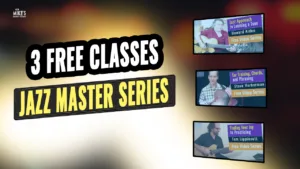Virtually all jazz guitarists are accustomed to the idea of staying out of the way of the bassist and/or the pianist in an ensemble setting. However, often in smaller settings, the guitarist must take on the roll of the pianist and bassist.
While comping chords with the root in the bass and playing with rhythmic confidence can get the job done, a guitarist who has mastered the art of playing bass lines and comping chords simultaneously can add a whole new dimension to duos with a vocalist, a horn player, another guitarist, or many other configurations that lack a bass player.
If you’ve ever wanted to be able to add bass lines and chords to your comping in different jazz settings, or if you have the basics down and want to bring your playing to the next level, this class is for you.
Any guitarist attempting to play bass lines must realize the crucial importance of the bass role in an ensemble so we will first make a thorough study of creating bass lines in four different typical jazz styles and grooves: 4/4 walking swing tunes, jazz waltzes, jazz ballads, and bossa novas.
We will next explore the addition of chords to each style, using primarily the simple but all-important shell voicings.
This class offers a clear, systematic approach, helpful suggestions for gaining fluency with the concepts and the physical techniques, and plenty of examples and exercises for practice.
The Art of Bass and Chords for Jazz Guitar covers:
- five principles for creating strong bass parts
- three techniques for building walking bass lines
- techniques for one-chord-per-bar and two-chords-per-bar
- full length composed bass line on the chord changes of “Autumn Leaves” demonstrating different techniques
- bass lines on static chords
- upbeat notes and “chickety gongs” to enhance rhythmic drive and variety
- bass lines “in two”
- broken swing bass lines
- playing walking bass, “in one,” dotted quarters, and broken swing on jazz waltzes
- lyrical ballad approach
- basic bossa nova bass lines
- shell voicings for use with bass lines
- adding color tones/upper extensions to shell voicings
- discussion of right hand technique
- exercises for getting started combining chords and walking bass lines
- additional techniques for embellishing chord accompaniment to walking bass lines
- adding chords to bass lines “in two” and broken swing bass parts
- using half step approach chords and tritone substitute chords to harmonize bass lines
- using pedal tones with chords
- two full length real-world examples of walking bass and chord performances on “Autumn Leaves” and an F blues
- different techniques for adding chords to bass lines on jazz waltzes
- ballad approach combining bass and chords
- preliminary exercises for gaining rhythmic fluency and confidence for combining bass and chords on bossa novas
- full length example of bossa nova comping with bass on the chord changes to “Blue Bossa”
- additional examples of rhythmic variations for chord accompaniment
- 123 minute running time
- includes 30 pages of written examples and exercises
- All musical examples from the video are provided in music notation, tablature, and chord grid form.
- Each example performance is shown in close-up view and titled and numbered for easy navigation.












Very useful
I find Tom’s classes are always full value for the money with excellent written materials and clear demonstrations and explanations on the video. This course is no exception and I now try to prepare a walking bass and chords arrangement to every song I learn.
by Henry RutgersThinking like a bass player.
Still working through the course but have thoroughly enjoyed it thus far. A great resource for solo jazz guitar. Gives a guitarist like me a much-needed understanding of a bass player’s perspective.
by Joshua QuintanillaA course on jazz counterpoint from Tom would be fantastic.